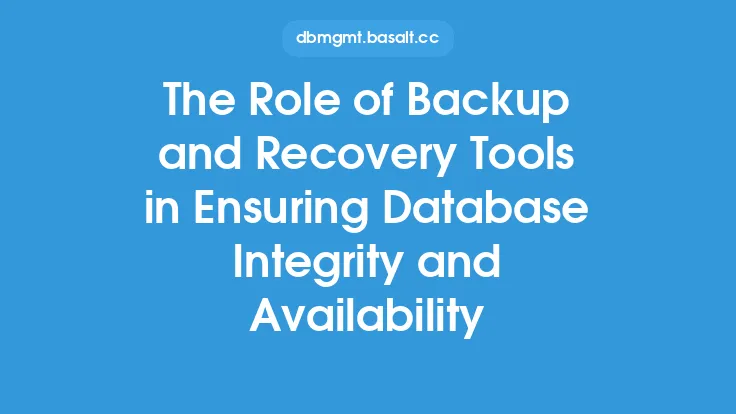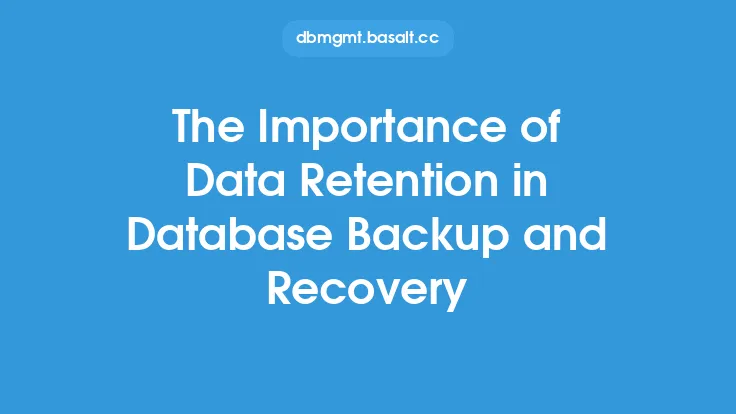Evaluating the effectiveness of backup and recovery tools is a critical aspect of database management. It involves assessing the ability of these tools to ensure data integrity, availability, and recoverability in the event of a disaster or data loss. The primary goal of backup and recovery tools is to provide a reliable and efficient means of restoring data to a consistent state, minimizing downtime and data loss.
Introduction to Backup and Recovery Tools
Backup and recovery tools are designed to protect database systems from data loss and corruption. These tools create copies of database files, logs, and other relevant data, which can be used to restore the database to a previous state in case of a failure. The effectiveness of backup and recovery tools depends on several factors, including the type of backup, frequency of backups, and the ability to recover data quickly and accurately.
Types of Backup and Recovery Tools
There are several types of backup and recovery tools available, each with its own strengths and weaknesses. These include full backups, incremental backups, differential backups, and transaction log backups. Full backups involve creating a complete copy of the database, while incremental and differential backups involve creating copies of only the changes made since the last backup. Transaction log backups involve creating copies of the transaction logs, which can be used to recover the database to a specific point in time.
Evaluating Backup and Recovery Tool Effectiveness
Evaluating the effectiveness of backup and recovery tools involves assessing their ability to meet the recovery time objective (RTO) and recovery point objective (RPO). The RTO refers to the maximum amount of time that can be tolerated for data recovery, while the RPO refers to the maximum amount of data that can be lost in the event of a failure. Backup and recovery tools should be able to recover data quickly and accurately, with minimal data loss and downtime.
Key Performance Indicators (KPIs) for Backup and Recovery Tools
Several key performance indicators (KPIs) can be used to evaluate the effectiveness of backup and recovery tools. These include backup completion rate, backup window, recovery time, data loss, and system downtime. The backup completion rate refers to the percentage of backups that complete successfully, while the backup window refers to the amount of time required to complete a backup. The recovery time refers to the amount of time required to recover data, while data loss refers to the amount of data that is lost in the event of a failure.
Best Practices for Evaluating Backup and Recovery Tool Effectiveness
Several best practices can be followed to evaluate the effectiveness of backup and recovery tools. These include regularly testing backup and recovery processes, monitoring backup and recovery performance, and analyzing backup and recovery logs. Regular testing ensures that backup and recovery processes are working correctly, while monitoring performance ensures that backup and recovery tools are meeting their RTO and RPO. Analyzing logs helps to identify any issues or errors that may be occurring during the backup and recovery process.
Common Challenges in Evaluating Backup and Recovery Tool Effectiveness
Several common challenges can arise when evaluating the effectiveness of backup and recovery tools. These include inadequate testing, insufficient monitoring, and lack of documentation. Inadequate testing can lead to a false sense of security, while insufficient monitoring can make it difficult to identify issues or errors. Lack of documentation can make it difficult to understand the backup and recovery process, making it challenging to evaluate its effectiveness.
Conclusion
Evaluating the effectiveness of backup and recovery tools is a critical aspect of database management. It involves assessing the ability of these tools to ensure data integrity, availability, and recoverability in the event of a disaster or data loss. By following best practices, using key performance indicators, and understanding the types of backup and recovery tools available, database administrators can ensure that their backup and recovery tools are effective and reliable. Regular testing, monitoring, and analysis of backup and recovery logs are essential to ensure that backup and recovery tools are meeting their RTO and RPO, and that data is protected and recoverable in the event of a failure.





